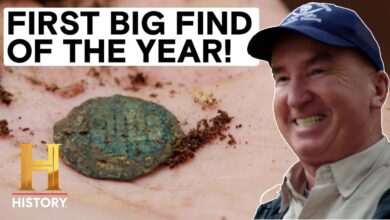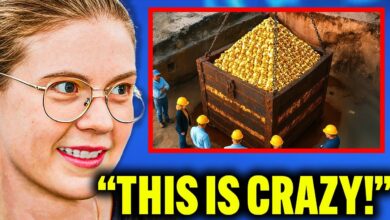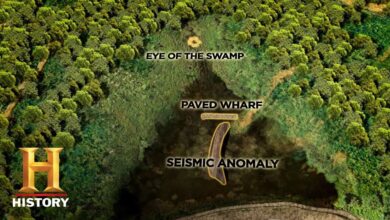The Curse of Oak Island Season 12 Episode 13: Detects Vibrations from Steel Caissons in Money Pit
The Curse of Oak Island Season 12 Episode 13: Detects Vibrations from Steel Caissons in Money Pit

Hey guys, season 12 of The Curse of Oak Island continues to captivate audiences, and episode 13, “Cas’s Ho,” takes the hunt for the legendary treasure to new depths. Literally. The Lagina brothers and their dedicated team embark on an ambitious excavation of The Money Pit, deploying massive steel casing in an attempt to finally reach the fabled Chapel Vault.
At the same time, intriguing discoveries on Lot 5 and in the swamp hint at connections to historical treasure deposits. Could this be the moment that changes everything?
The highlight of the episode revolved around the team’s determined effort to drill deep into The Money Pit, targeting the long-rumored Chapel Vault, first encountered by treasure hunter Frederick Blair and driller William Chapel in 1897. At a depth of 153 feet, the vault was described as a 7-foot-high, concrete-encased chamber potentially holding gold, historical artifacts, or clues to Oak Island’s biggest mystery.
For months, the team meticulously analyzed core drilling results and groundwater samples, which suggested the presence of man-made structures and traces of precious metals deep underground. With these promising signs, they enlisted the help of Vanessa Lucido from Rock Equipment to deploy massive 7-foot-wide steel casing. The plan was to bore down over 200 feet, if necessary, overcoming obstacles that had thwarted previous searchers.
As the first casing, ceremonially named “True Believer,” began its descent, anticipation was high. The team struck wood at 87 feet, some of which bore axe or adze marks, indicating it could be part of an old underground structure. Then, at 91 feet, they unearthed a massive wrought-iron spike, possibly from an early treasure hunting expedition or even the original Money Pit defenses.
As they dug deeper, the team eagerly awaited further clues that could validate the Chapel Vault’s existence. While The Money Pit excavation progressed, another shocking discovery unfolded on Lot 5, an area that has produced significant artifacts in the past. Jack Begley, archaeologist Fiona Steele, and assistant Todd Langth stumbled on a dazzling object buried in the soil—an apparent gemstone or diamond-like artifact. At first glance, the discovery hinted at immense historical and monetary value, raising the possibility that a figure of great wealth or importance had once been on Oak Island.
However, after lab analysis by archaeologist Lar Nen and archaeometallurgist Emma Culligan, the truth was revealed: the diamond was actually a highly content-paced jewel, an artificial gemstone popular in the early 18th century, particularly in France. Despite not being a real diamond, the artifact was still an important find. The craftsmanship and era of the jewel aligned with the 1746 expedition of French Admiral Duc d’Enville, who was rumored to have connections to hidden treasure deposits in Nova Scotia. This discovery supported the theory that Lot 5 may have served as a staging ground for treasure movements or concealment efforts centuries ago.
Meanwhile, in the northern part of the swamp, another revelation took shape. Rick Lagina, Alex Lagina, and geoscientist Dr. Ian Spooner investigated a newly exposed wooden structure at a depth of 3 feet, accompanied by stacked rocks. The find bore a striking resemblance to previously discovered cobblestone pathways and a slate vault, both of which hinted at man-made engineering dating back hundreds of years. Dr. Spooner analyzed the site and determined that the structure was likely built for cargo transport.
If so, this could be a game-changer. For years, theories have suggested that Oak Island’s swamp may have been artificially created to hide treasure or facilitate secretive operations. Could this discovery point to long-lost transportation routes used to move treasure from ships to underground caches? While definitive proof remains elusive, the team was more motivated than ever to continue digging deeper into the swamp’s enigmatic past.
In addition to the discoveries in The Money Pit, Lot 5, and the swamp, another piece of the puzzle emerged from a past find. A hand-forged iron spike, previously recovered on Lot 1 near a boulder referenced in Blair’s treasure map, was examined by blacksmithing expert Carmen Leg, dating the artifact to the early to mid-1700s. Leg theorized that it might have been used to anchor a boulder in place, possibly as part of a larger treasure marking system. This coincided with theories surrounding Duc d’Enville’s failed Nova Scotia campaign, which included plans to bury treasure in a secret pit connected by underground tunnels.
However, not everyone in the lab agreed. Culligan, reviewing the artifact separately, suggested a later date, possibly the late 1700s. This small but significant debate underscored the ongoing challenge of interpreting Oak Island’s mysterious relics and deciphering their true origins.
As the casing continued digging in The Money Pit, the team employed a wash plant, overseen by Rick Lagina, Scott Barlo, and Billy Gart, to sift through the spoils. Among the discoveries was a heavy square metal fragment with signs of advanced craftsmanship. The artifact’s purpose and age remained uncertain, but its presence reinforced the belief that something significant might be buried deep within The Money Pit. Could it be part of the Chapel Vault’s defenses, or was it merely another remnant from previous treasure hunting expeditions?
Regardless, the team remained optimistic, knowing that every find brought them closer to their ultimate goal. With so many discoveries in episode 13, ranging from the mysterious gemstone on Lot 5 to the unexplained wooden structure in the swamp, the Lagina brothers and their team are at a crucial turning point. The massive excavation in The Money Pit has yielded promising clues, but the ultimate prize, the Chapel Vault, still remains just out of reach.
As the season progresses, the team will undoubtedly push forward with more excavations, testing, and historical research. The recent discoveries continue to reinforce long-held theories that Oak Island was used as a secretive site for treasure concealment, potentially linked to historical figures such as the Knights Templar, French naval officers, or wealthy privateers. However, Oak Island has a history of leading treasure hunters down promising paths, only to end in frustrating dead ends. Will The Curse of Oak Island finally break this cycle, or will the mystery remain unsolved for yet another season?
One of the most tantalizing questions following episode 13 is whether the team is finally closing in on the legendary Chapel Vault. For years, the Oak Island crew has been chasing clues that point toward this elusive underground chamber. The recent findings—wooden structures, iron spikes, and metal fragments—suggest they may be closer than ever before.
However, history has shown that The Money Pit is full of surprises. Previous expeditions have encountered flood tunnels, collapsed structures, and shifting underground layers that have frustrated treasure hunters for centuries. While the massive casing provides unprecedented access to deep underground locations, the real test will come when the team reaches the suspected depth of 153 feet, where the Chapel Vault was originally detected. Will they finally recover physical evidence of its existence, or will it remain yet another Oak Island enigma?
Lot 5 has continued to provide intriguing finds, adding to the growing theory that this area played a significant role in Oak Island’s past. The discovery of the past jewel, while not a real diamond, suggests a possible link to an 18th-century aristocrat or naval officer. If this is the case, who could have hidden such artifacts here? One of the leading theories involves Admiral Duc d’Enville, who led a failed French expedition to Nova Scotia in 1746. His fleet suffered devastating losses, and some believe he may have secretly buried treasure on Oak Island before his mission fell apart. The presence of high-quality French artifacts supports this idea. Could Lot 5 have been a hidden staging ground for treasure concealment? If so, there may be even more valuable discoveries waiting just beneath the surface.
The new wooden structure found in the swamp has added fuel to the long-running speculation that this area was artificially modified to conceal treasure. In previous seasons, the team has uncovered a cobblestone road, evidence of ancient ship activity, and even what appeared to be a sunken ship fragment. Now, with a newly uncovered structure accompanied by stacked rocks, the mystery has deepened. Dr. Ian Spooner’s assessment that the structure was likely man-made raises important questions. Could the swamp have been an essential part of an elaborate treasure concealment system? Some believe that tunnels may have been built beneath the swamp to transport treasure inland. If this is true, the team’s latest discovery could be a vital clue to unlocking Oak Island’s biggest secret.
The iron spike found on Lot 1 has sparked a fascinating debate among the team’s experts. Blacksmith Carmen Leg suggested that it dates back to the early 1700s and may have been used to secure boulders, possibly as part of an elaborate marker system for treasure hunters. However, Emma Culligan argued that the artifact could be from the late 1700s, leading to a clash of interpretations. While the exact age of the spike remains uncertain, its presence near boulders mentioned in an old treasure map raises intriguing possibilities.
If the artifact is linked to an 18th-century treasure hiding operation, it could provide a crucial connection between historical records and the physical evidence found on Oak Island. This discovery highlights how even small artifacts can play a significant role in unraveling the island’s mysterious past.
As the team continues to sift through excavated materials using the wash plant, each new find adds another piece to the puzzle. The heavy metal fragment recently uncovered in The Money Pit spoils is particularly intriguing. Although its exact purpose remains unknown, it hints at the presence of more complex underground structures. Could this artifact be part of an ancient chest, a vault, or even a lost piece of valuable machinery? The team’s careful analysis in the coming episodes will be crucial in determining whether they are digging in the right place. If the wash plant continues to produce promising finds, it may indicate that they are on the verge of a major breakthrough.
With so many discoveries in episode 13, the excitement is at an all-time high. The team has multiple promising leads: deeper excavations in The Money Pit, further exploration of Lot 5, and continued analysis of the swamp’s mysterious structures. The key question remains: will any of these discoveries finally lead to the legendary treasure? As the season progresses, fans can expect more dramatic developments, heated debates among experts, and perhaps even the unearthing of something truly groundbreaking. For now, the Lagina brothers and their team remain relentless in their pursuit, determined to uncover the truth behind Oak Island’s centuries-old mystery.
Will their perseverance finally pay off? Only time will tell.
[Music]








